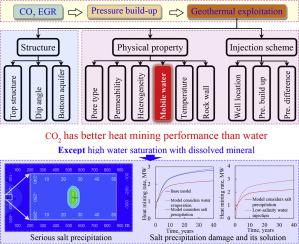Geoscience Frontiers ( IF 8.9 ) Pub Date : 2020-10-02 , DOI: 10.1016/j.gsf.2020.08.014 Guodong Cui , Shaoran Ren , Bin Dou , Fulong Ning

|
CO2 can be used as an alternative injectant to exploit geothermal energy from depleted high-temperature gas reservoirs due to its high mobility and unique thermal properties. However, there has been a lack of systematical analysis on the heat mining mechanism and performance of CO2, as well as the problems that may occur during geothermal energy exploitation at specific gas reservoir conditions. In this paper, a base numerical simulation model of a typical depleted high-temperature gas reservoir was established to simulate the geothermal energy exploitation processes via recycling CO2 and water, to investigate whether and/or at which conditions CO2 is more suitable than water for geothermal energy exploitation. The problems that may occur during the CO2-based geothermal energy exploitation were also analyzed along with proposed feasible solutions. The results indicate that, for a depleted low-permeability gas reservoir with dimensions of 1000 m × 500 m × 50 m and temperature of 150 °C using a single injection-production well group for 40 years of operation, the heat mining rate of CO2 can be up to 3.8 MW at a circulation flow rate of 18 kg s−1 due to its high mobility along with the flow path in the gas reservoir, while the heat mining rate of water is only about 2 MW due to limitations on the injectivity and mobility. The reservoir physical property and injection-production scheme have some effects on the heat mining rate, but CO2 always has better performance than water at most reservoir and operation conditions, even under a high water saturation. The main problems for CO2 circulation are wellbore corrosion and salt precipitation that can occur when the reservoir has high water saturation and high salinity, in which serious salt precipitation can reduce formation permeability and result in a decline of CO2 heat mining rate (e.g. up to 24% reduction). It is proposed to apply a low-salinity water slug before CO2 injection to reduce the damage caused by salt precipitation. For high-permeability gas reservoirs with high water saturation and high salinity, the superiority of CO2 as a heat transmission fluid becomes obscure and water injection is recommended.
中文翻译:

通过回收CO 2从贫乏的高温气藏中开采地热能:优势和存在的问题
由于CO 2的高迁移率和独特的热特性,它可以用作替代注入剂,以从枯竭的高温气藏中开采地热能。但是,对于CO 2的热采机理和性能,以及在特定的气藏条件下进行地热能开采过程中可能出现的问题,缺乏系统的分析。本文建立了典型的贫乏高温气藏的基础数值模拟模型,通过循环利用CO 2和水来模拟地热能的开采过程,研究是否和/或在什么条件下CO 2比水更适合用于地热能源开发。还分析了基于CO 2的地热能开采过程中可能出现的问题,并提出了可行的解决方案。结果表明,对于使用单注采井组运行40年的,尺寸为1000 m×500 m×50 m,温度为150°C的枯竭低渗气藏,CO的采热率2在循环流量为18 kg s -1时可以达到3.8 MW由于其高的可移动性以及在储气库中的流动路径,而水的热采速率由于注入性和可移动性的限制而仅约为2 MW。储层的物性和注采方案对热采速率有一定的影响,但是即使在高含水饱和度的条件下,CO 2在大多数储层和运行条件下总是比水具有更好的性能。CO 2循环的主要问题是当储层具有高含水饱和度和高盐度时可能发生的井筒腐蚀和盐分沉淀,其中严重的盐分沉淀会降低地层渗透率并导致CO 2下降采暖率(例如降低多达24%)。建议在注入CO 2之前使用低盐度的水塞,以减少盐沉淀所造成的损害。对于具有高水饱和度和高盐度的高渗透率气藏,CO 2作为传热流体的优越性变得晦涩,建议注水。

























 京公网安备 11010802027423号
京公网安备 11010802027423号